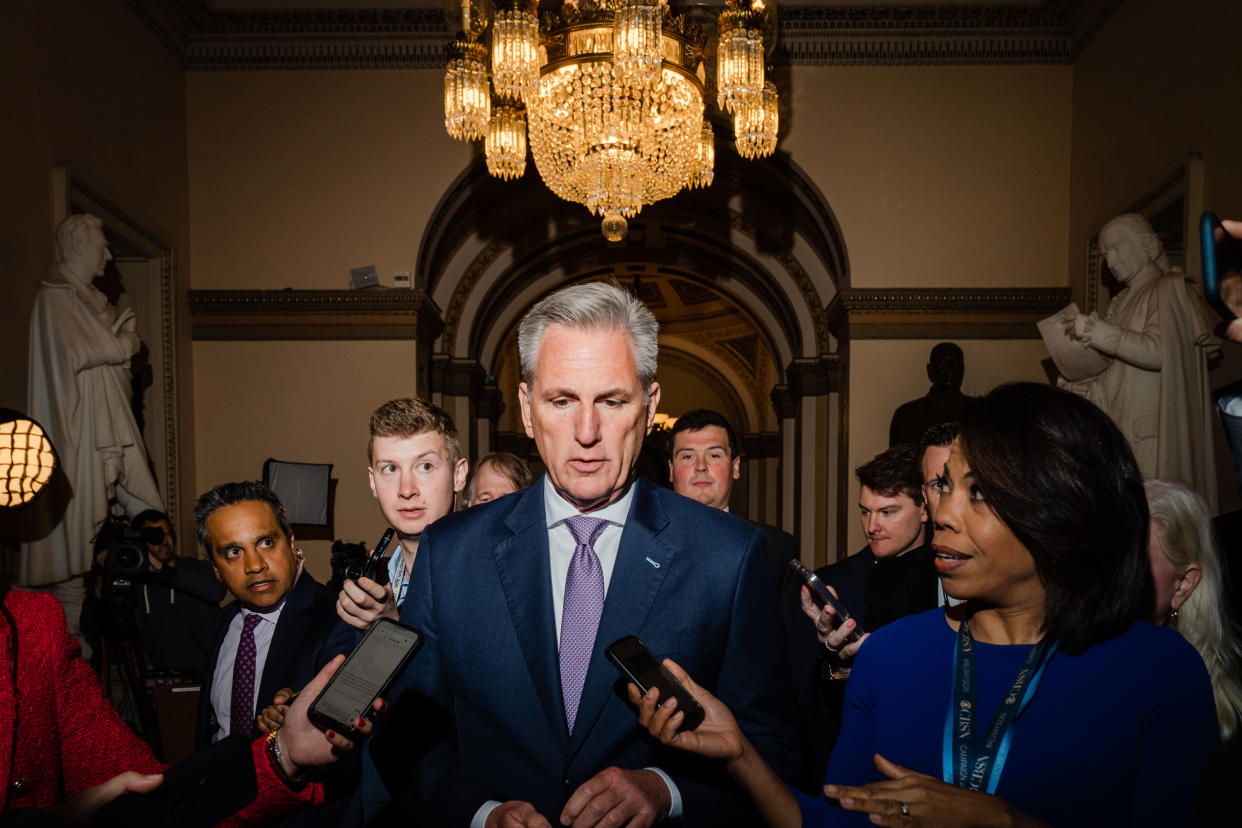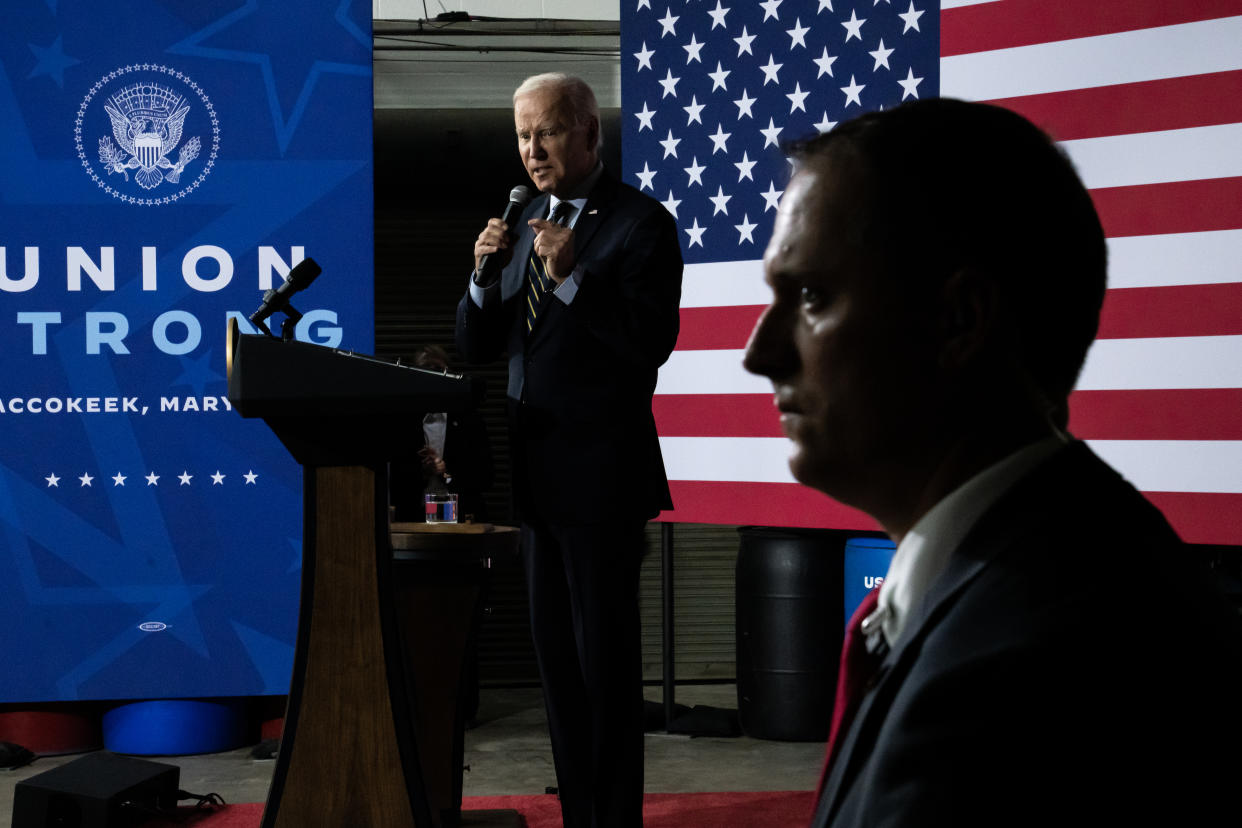House GOP debt ceiling plan would cap future government spending
Speaker Kevin McCarthy (R-CA) on Wednesday unveiled his party’s highly-anticipated debt ceiling proposal, saying he's willing to lift the limit by $1.5 trillion or until March 31, 2024 — whichever comes first — but only if Democrats agree to a host of other measures.
“I urge all my colleagues on both sides of the aisle to support this plan to get our nation back on track,” McCarthy said on the floor of the U.S. House after months of waiting to introduce a plan, claiming those measures will save taxpayers $4.5 trillion over the next decade.
But many of the key GOP priorities in the 320-page bill — which includes things like a cap on government spending and a reversal of parts of Biden's agenda — are deeply opposed by Democrats, making it unclear how the two sides will come together before the debt limit is reached, possibly in June. A government default would have far-reaching consequences for world markets and, many fear, immediately tip the U.S. economy into a recession.

“Not everybody sees the same way as the Speaker does or as the conservative wing of the Republican Party does," Stifel Chief Washington Policy Strategist Brian Gardner told Yahoo Finance Live Tuesday after details of the proposal leaked out, noting the passage of the bill in the House is far from a sure thing.
If it does pass, McCarthy and others say that will force President Joe Biden and other Democrats to come to the negotiating table and abandon their party's position that the only acceptable action now is to raise the debt ceiling without any conditions.
Here’s some highlights of the GOP plan.
Caps on spending and ‘clawing back’ COVID-19 money
The centerpiece of the bill, which has been dubbed the “Limit, Save, Grow Act of 2023,” are caps of government spending with a proposal to return discretionary spending to FY2022 levels and then impose a 1% increase limit on government spending after that.
These measures, Republicans say, would impose fiscal discipline on Washington that has been lacking in recent years. Meanwhile, critics say the plan would disproportionately place the responsibility for saving money on government social programs, while avoiding major cuts to the Pentagon and veteran services, two politically popular programs that McCarthy has said will largely be spared.
The plan also include provisions to claw back unspent money from the flurry of COVID-19 relief bills passed in recent years that are projected to return additional billions of dollars to government coffers.
The bill got one early positive review Wednesday afternoon when Maya MacGuineas, president of the Committee for a Responsible Federal Budget, said in a statement that the “bill is not sufficient to bring our debt to manageable levels, but is a realistic and extremely welcome first step.”
Taking aim at the Biden legacy
The bill also seeks to reverse some of the central accomplishments of the Biden administration's early years in office, including large chunks of the Inflation Reduction Act — perhaps the president's most cherished accomplishment.
First, it would undo a host of what the bill calls “market distorting green energy tax credits” that are focused on amplifying the US government’s ability to respond to climate change. The bill would also reverse $80 billion in new funding set to go to that Internal Revenue Service in the coming decade intended to close the tax gap and pay for better service. Republicans, though, have warned the IRS funding would lead to an “army of 87,000 IRS agents.”
The GOP proposal would also kill President Biden’s recent push via executive action to forgive student loan debt. That is an effort that is already tied up in legal challenges with the Supreme Court expected to decide its fate in the coming months.
Another measure includes in the package is called the “REINS act,” which targets what Republicans describe as Biden’s executive overreach.

A focus on energy and controversial new work requirements
There is also a large swath of the bill devoted to energy.
In March, the House passed HR1 — what Republicans dubbed their top priority — around a suite of energy reforms. The law sought to open up new areas of America for fossil fuel production and for mining as well as speed up the permitting process for energy projects.
That bill was dead on arrival in the Democratic-controlled Senate, but is getting another life after being included in Wednesday’s debt limit bill.
The bill also seeks to impose controversial new work requirements on low-income Americans who participate in federal programs like food stamps and Medicaid. These benefits would continue, but only in exchange for a requirement that these recipients work longer hours.
In his speech, McCarthy said they were “common sense measures” that would help “rebuild the workforce.”
The inclusion of these work requirements is a bid to satisfy the most conservative Republican members of McCarthy’s caucus who have been wary of the overall proposal. Some even suggested the bill may need to go further by repealing the entire Inflation Reduction Act to gain their support.
During an event in Maryland Wednesday afternoon, President Biden laid into the plan and the GOP approach to the debt ceiling, saying the Republican agenda is about taking away benefits for millions of lower-income Americans to preserve tax cuts for the richest Americans and biggest corporations.
"A minority of the party, what I call the MAGA Republicans, are in control of the party and they're in Congress threatening to undo all the stuff you've helped me get done" he told an audience of union members.
As for McCarthy, he said that now that his bill has been proposed, it’s time for talks to begin in earnest.
“Now that we've introduced a clear plan for a responsible debt limit increase, they have no more excuse and refuse to negotiate,” he said Wednesday.
Ben Werschkul is Washington correspondent for Yahoo Finance.
Click here for politics news related to business and money
Read the latest financial and business news from Yahoo Finance
Download the Yahoo Finance app for Apple or Android
Follow Yahoo Finance on Twitter, Facebook, Instagram, Flipboard, LinkedIn, and YouTube
